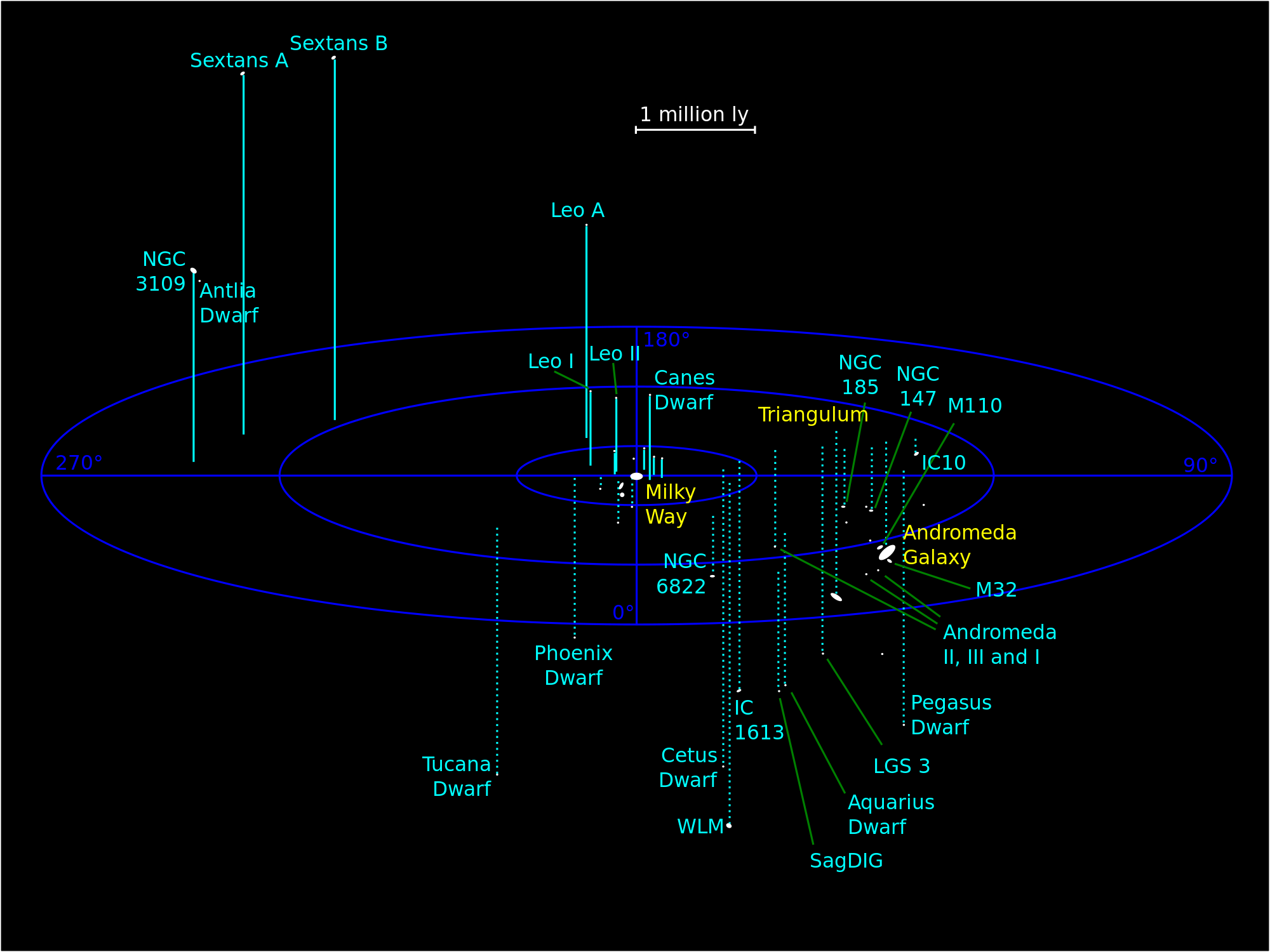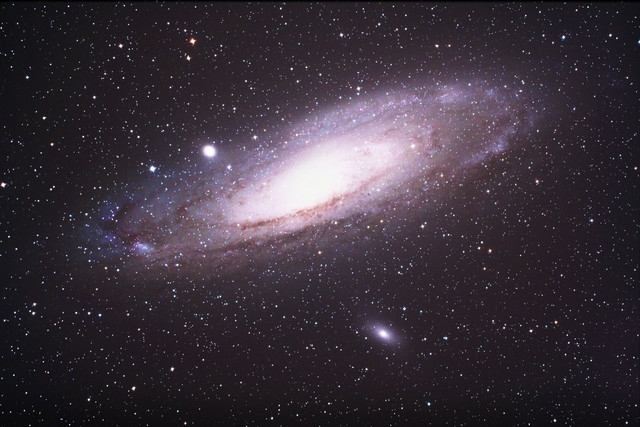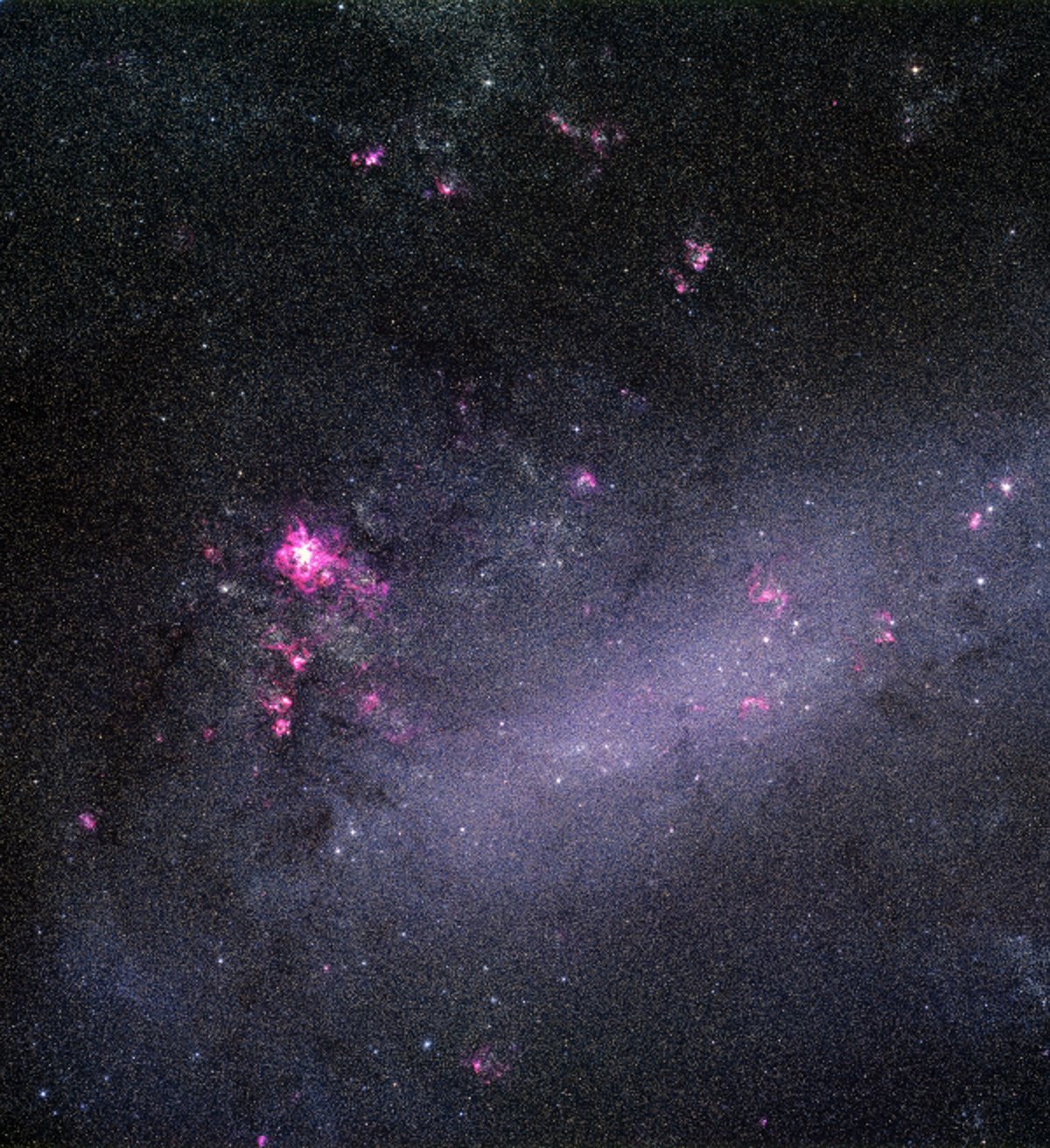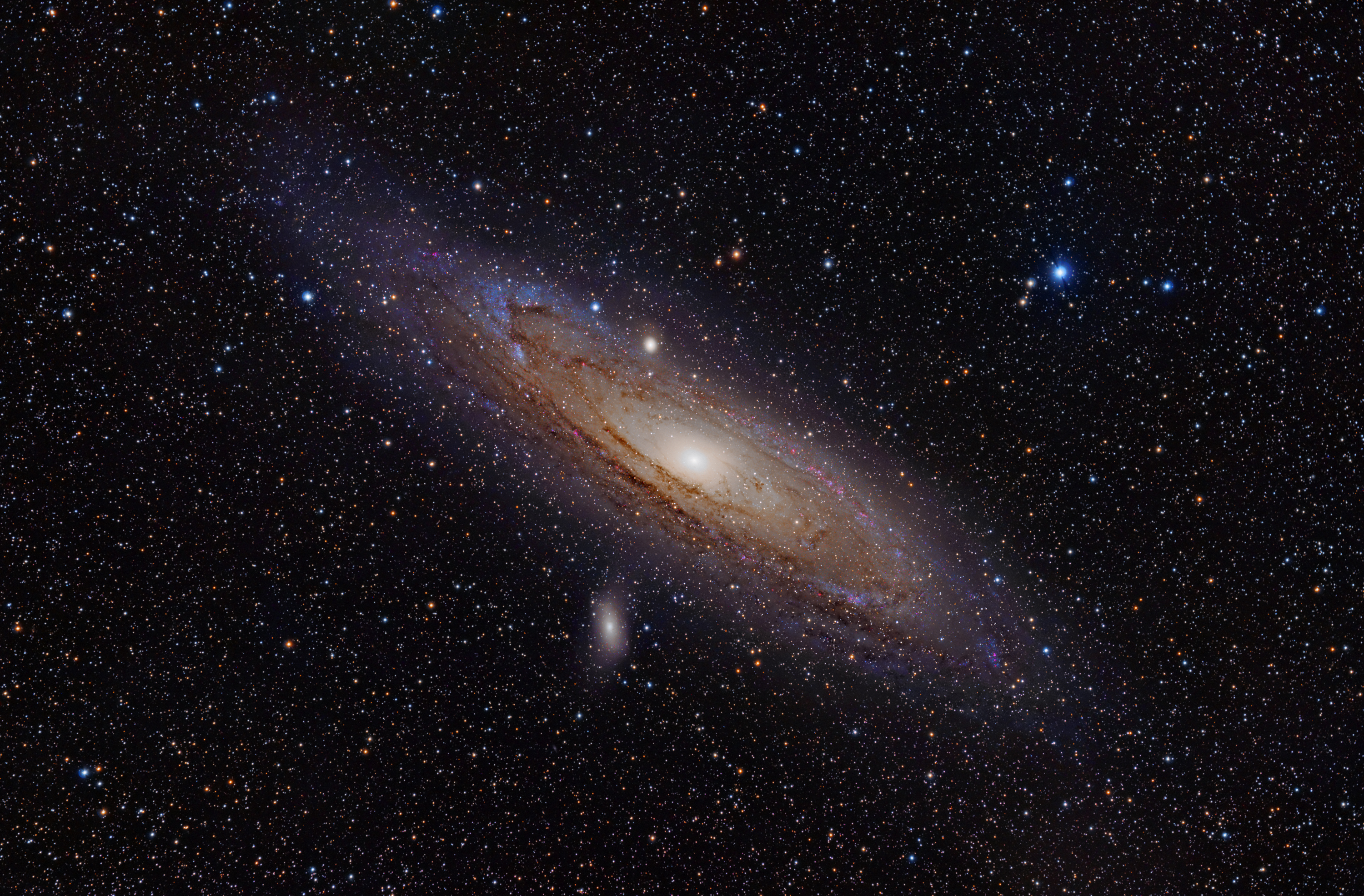Chapter 15: Galaxies
Chapter 1
How Science Works
- The Scientific Method
- Evidence
- Measurements
- Units and the Metric System
- Measurement Errors
- Estimation
- Dimensions
- Mass, Length, and Time
- Observations and Uncertainty
- Precision and Significant Figures
- Errors and Statistics
- Scientific Notation
- Ways of Representing Data
- Logic
- Mathematics
- Geometry
- Algebra
- Logarithms
- Testing a Hypothesis
- Case Study of Life on Mars
- Theories
- Systems of Knowledge
- The Culture of Science
- Computer Simulations
- Modern Scientific Research
- The Scope of Astronomy
- Astronomy as a Science
- A Scale Model of Space
- A Scale Model of Time
- Questions
Chapter 2
Early Astronomy
- The Night Sky
- Motions in the Sky
- Navigation
- Constellations and Seasons
- Cause of the Seasons
- The Magnitude System
- Angular Size and Linear Size
- Phases of the Moon
- Eclipses
- Auroras
- Dividing Time
- Solar and Lunar Calendars
- History of Astronomy
- Stonehenge
- Ancient Observatories
- Counting and Measurement
- Astrology
- Greek Astronomy
- Aristotle and Geocentric Cosmology
- Aristarchus and Heliocentric Cosmology
- The Dark Ages
- Arab Astronomy
- Indian Astronomy
- Chinese Astronomy
- Mayan Astronomy
- Questions
Chapter 3
The Copernican Revolution
- Ptolemy and the Geocentric Model
- The Renaissance
- Copernicus and the Heliocentric Model
- Tycho Brahe
- Johannes Kepler
- Elliptical Orbits
- Kepler's Laws
- Galileo Galilei
- The Trial of Galileo
- Isaac Newton
- Newton's Law of Gravity
- The Plurality of Worlds
- The Birth of Modern Science
- Layout of the Solar System
- Scale of the Solar System
- The Idea of Space Exploration
- Orbits
- History of Space Exploration
- Moon Landings
- International Space Station
- Manned versus Robotic Missions
- Commercial Space Flight
- Future of Space Exploration
- Living in Space
- Moon, Mars, and Beyond
- Societies in Space
- Questions
Chapter 4
Matter and Energy in the Universe
- Matter and Energy
- Rutherford and Atomic Structure
- Early Greek Physics
- Dalton and Atoms
- The Periodic Table
- Structure of the Atom
- Energy
- Heat and Temperature
- Potential and Kinetic Energy
- Conservation of Energy
- Velocity of Gas Particles
- States of Matter
- Thermodynamics
- Entropy
- Laws of Thermodynamics
- Heat Transfer
- Thermal Radiation
- Wien's Law
- Radiation from Planets and Stars
- Internal Heat in Planets and Stars
- Periodic Processes
- Random Processes
- Questions
Chapter 5
The Earth-Moon System
- Earth and Moon
- Early Estimates of Earth's Age
- How the Earth Cooled
- Ages Using Radioactivity
- Radioactive Half-Life
- Ages of the Earth and Moon
- Geological Activity
- Internal Structure of the Earth and Moon
- Basic Rock Types
- Layers of the Earth and Moon
- Origin of Water on Earth
- The Evolving Earth
- Plate Tectonics
- Volcanoes
- Geological Processes
- Impact Craters
- The Geological Timescale
- Mass Extinctions
- Evolution and the Cosmic Environment
- Earth's Atmosphere and Oceans
- Weather Circulation
- Environmental Change on Earth
- The Earth-Moon System
- Geological History of the Moon
- Tidal Forces
- Effects of Tidal Forces
- Historical Studies of the Moon
- Lunar Surface
- Ice on the Moon
- Origin of the Moon
- Humans on the Moon
- Questions
Chapter 6
The Terrestrial Planets
- Studying Other Planets
- The Planets
- The Terrestrial Planets
- Mercury
- Mercury's Orbit
- Mercury's Surface
- Venus
- Volcanism on Venus
- Venus and the Greenhouse Effect
- Tectonics on Venus
- Exploring Venus
- Mars in Myth and Legend
- Early Studies of Mars
- Mars Close-Up
- Modern Views of Mars
- Missions to Mars
- Geology of Mars
- Water on Mars
- Polar Caps of Mars
- Climate Change on Mars
- Terraforming Mars
- Life on Mars
- The Moons of Mars
- Martian Meteorites
- Comparative Planetology
- Incidence of Craters
- Counting Craters
- Counting Statistics
- Internal Heat and Geological Activity
- Magnetic Fields of the Terrestrial Planets
- Mountains and Rifts
- Radar Studies of Planetary Surfaces
- Laser Ranging and Altimetry
- Gravity and Atmospheres
- Normal Atmospheric Composition
- The Significance of Oxygen
- Questions
Chapter 7
The Giant Planets and Their Moons
- The Gas Giant Planets
- Atmospheres of the Gas Giant Planets
- Clouds and Weather on Gas Giant Planets
- Internal Structure of the Gas Giant Planets
- Thermal Radiation from Gas Giant Planets
- Life on Gas Giant Planets?
- Why Giant Planets are Giant
- Gas Laws
- Ring Systems of the Giant Planets
- Structure Within Ring Systems
- The Origin of Ring Particles
- The Roche Limit
- Resonance and Harmonics
- Tidal Forces in the Solar System
- Moons of Gas Giant Planets
- Geology of Large Moons
- The Voyager Missions
- Jupiter
- Jupiter's Galilean Moons
- Jupiter's Ganymede
- Jupiter's Europa
- Jupiter's Callisto
- Jupiter's Io
- Volcanoes on Io
- Saturn
- Cassini Mission to Saturn
- Saturn's Titan
- Saturn's Enceladus
- Discovery of Uranus and Neptune
- Uranus
- Uranus' Miranda
- Neptune
- Neptune's Triton
- Pluto
- The Discovery of Pluto
- Pluto as a Dwarf Planet
- Dwarf Planets
- Questions
Chapter 8
Interplanetary Bodies
- Interplanetary Bodies
- Comets
- Early Observations of Comets
- Structure of the Comet Nucleus
- Comet Chemistry
- Oort Cloud and Kuiper Belt
- Kuiper Belt
- Comet Orbits
- Life Story of Comets
- The Largest Kuiper Belt Objects
- Meteors and Meteor Showers
- Gravitational Perturbations
- Asteroids
- Surveys for Earth Crossing Asteroids
- Asteroid Shapes
- Composition of Asteroids
- Introduction to Meteorites
- Origin of Meteorites
- Types of Meteorites
- The Tunguska Event
- The Threat from Space
- Probability and Impacts
- Impact on Jupiter
- Interplanetary Opportunity
- Questions
Chapter 9
Planet Formation and Exoplanets
- Formation of the Solar System
- Early History of the Solar System
- Conservation of Angular Momentum
- Angular Momentum in a Collapsing Cloud
- Helmholtz Contraction
- Safronov and Planet Formation
- Collapse of the Solar Nebula
- Why the Solar System Collapsed
- From Planetesimals to Planets
- Accretion and Solar System Bodies
- Differentiation
- Planetary Magnetic Fields
- The Origin of Satellites
- Solar System Debris and Formation
- Gradual Evolution and a Few Catastrophies
- Chaos and Determinism
- Extrasolar Planets
- Discoveries of Exoplanets
- Doppler Detection of Exoplanets
- Transit Detection of Exoplanets
- The Kepler Mission
- Direct Detection of Exoplanets
- Properties of Exoplanets
- Implications of Exoplanet Surveys
- Future Detection of Exoplanets
- Questions
Chapter 10
Detecting Radiation from Space
- Observing the Universe
- Radiation and the Universe
- The Nature of Light
- The Electromagnetic Spectrum
- Properties of Waves
- Waves and Particles
- How Radiation Travels
- Properties of Electromagnetic Radiation
- The Doppler Effect
- Invisible Radiation
- Thermal Spectra
- The Quantum Theory
- The Uncertainty Principle
- Spectral Lines
- Emission Lines and Bands
- Absorption and Emission Spectra
- Kirchoff's Laws
- Astronomical Detection of Radiation
- The Telescope
- Optical Telescopes
- Optical Detectors
- Adaptive Optics
- Image Processing
- Digital Information
- Radio Telescopes
- Telescopes in Space
- Hubble Space Telescope
- Interferometry
- Collecting Area and Resolution
- Frontier Observatories
- Questions
Chapter 11
Our Sun: The Nearest Star
- The Sun
- The Nearest Star
- Properties of the Sun
- Kelvin and the Sun's Age
- The Sun's Composition
- Energy From Atomic Nuclei
- Mass-Energy Conversion
- Examples of Mass-Energy Conversion
- Energy From Nuclear Fission
- Energy From Nuclear Fusion
- Nuclear Reactions in the Sun
- The Sun's Interior
- Energy Flow in the Sun
- Collisions and Opacity
- Solar Neutrinos
- Solar Oscillations
- The Sun's Atmosphere
- Solar Chromosphere and Corona
- Sunspots
- The Solar Cycle
- The Solar Wind
- Effects of the Sun on the Earth
- Cosmic Energy Sources
- Questions
Chapter 12
Properties of Stars
- Stars
- Star Names
- Star Properties
- The Distance to Stars
- Apparent Brightness
- Absolute Brightness
- Measuring Star Distances
- Stellar Parallax
- Spectra of Stars
- Spectral Classification
- Temperature and Spectral Class
- Stellar Composition
- Stellar Motion
- Stellar Luminosity
- The Size of Stars
- Stefan-Boltzmann Law
- Stellar Mass
- Hydrostatic Equilibrium
- Stellar Classification
- The Hertzsprung-Russell Diagram
- Volume and Brightness Selected Samples
- Stars of Different Sizes
- Understanding the Main Sequence
- Stellar Structure
- Stellar Evolution
- Questions
Chapter 13
Star Birth and Death
- Star Birth and Death
- Understanding Star Birth and Death
- Cosmic Abundance of Elements
- Star Formation
- Molecular Clouds
- Young Stars
- T Tauri Stars
- Mass Limits for Stars
- Brown Dwarfs
- Young Star Clusters
- Cauldron of the Elements
- Main Sequence Stars
- Nuclear Reactions in Main Sequence Stars
- Main Sequence Lifetimes
- Evolved Stars
- Cycles of Star Life and Death
- The Creation of Heavy Elements
- Red Giants
- Horizontal Branch and Asymptotic Giant Branch Stars
- Variable Stars
- Magnetic Stars
- Stellar Mass Loss
- White Dwarfs
- Supernovae
- Seeing the Death of a Star
- Supernova 1987A
- Neutron Stars and Pulsars
- Special Theory of Relativity
- General Theory of Relativity
- Black Holes
- Properties of Black Holes
- Questions
Chapter 14
The Milky Way
- The Distribution of Stars in Space
- Stellar Companions
- Binary Star Systems
- Binary and Multiple Stars
- Mass Transfer in Binaries
- Binaries and Stellar Mass
- Nova and Supernova
- Exotic Binary Systems
- Gamma Ray Bursts
- How Multiple Stars Form
- Environments of Stars
- The Interstellar Medium
- Effects of Interstellar Material on Starlight
- Structure of the Interstellar Medium
- Dust Extinction and Reddening
- Groups of Stars
- Open Star Clusters
- Globular Star Clusters
- Distances to Groups of Stars
- Ages of Groups of Stars
- Layout of the Milky Way
- William Herschel
- Isotropy and Anisotropy
- Mapping the Milky Way
- Questions
Chapter 16
The Expanding Universe
- Galaxy Redshifts
- The Expanding Universe
- Cosmological Redshifts
- The Hubble Relation
- Relating Redshift and Distance
- Galaxy Distance Indicators
- Size and Age of the Universe
- The Hubble Constant
- Large Scale Structure
- Galaxy Clustering
- Clusters of Galaxies
- Overview of Large Scale Structure
- Dark Matter on the Largest Scales
- The Most Distant Galaxies
- Black Holes in Nearby Galaxies
- Active Galaxies
- Radio Galaxies
- The Discovery of Quasars
- Quasars
- Types of Gravitational Lensing
- Properties of Quasars
- The Quasar Power Source
- Quasars as Probes of the Universe
- Star Formation History of the Universe
- Expansion History of the Universe
- Questions
Chapter 17
Cosmology
- Cosmology
- Early Cosmologies
- Relativity and Cosmology
- The Big Bang Model
- The Cosmological Principle
- Universal Expansion
- Cosmic Nucleosynthesis
- Cosmic Microwave Background Radiation
- Discovery of the Microwave Background Radiation
- Measuring Space Curvature
- Cosmic Evolution
- Evolution of Structure
- Mean Cosmic Density
- Critical Density
- Dark Matter and Dark Energy
- Age of the Universe
- Precision Cosmology
- The Future of the Contents of the Universe
- Fate of the Universe
- Alternatives to the Big Bang Model
- Space-Time
- Particles and Radiation
- The Very Early Universe
- Mass and Energy in the Early Universe
- Matter and Antimatter
- The Forces of Nature
- Fine-Tuning in Cosmology
- The Anthropic Principle in Cosmology
- String Theory and Cosmology
- The Multiverse
- The Limits of Knowledge
- Questions
Chapter 18
Life On Earth
- Nature of Life
- Chemistry of Life
- Molecules of Life
- The Origin of Life on Earth
- Origin of Complex Molecules
- Miller-Urey Experiment
- Pre-RNA World
- RNA World
- From Molecules to Cells
- Metabolism
- Anaerobes
- Extremophiles
- Thermophiles
- Psychrophiles
- Xerophiles
- Halophiles
- Barophiles
- Acidophiles
- Alkaliphiles
- Radiation Resistant Biology
- Importance of Water for Life
- Hydrothermal Systems
- Silicon Versus Carbon
- DNA and Heredity
- Life as Digital Information
- Synthetic Biology
- Life in a Computer
- Natural Selection
- Tree Of Life
- Evolution and Intelligence
- Culture and Technology
- The Gaia Hypothesis
- Life and the Cosmic Environment
Chapter 19
Life in the Universe
- Life in the Universe
- Astrobiology
- Life Beyond Earth
- Sites for Life
- Complex Molecules in Space
- Life in the Solar System
- Lowell and Canals on Mars
- Implications of Life on Mars
- Extreme Environments in the Solar System
- Rare Earth Hypothesis
- Are We Alone?
- Unidentified Flying Objects or UFOs
- The Search for Extraterrestrial Intelligence
- The Drake Equation
- The History of SETI
- Recent SETI Projects
- Recognizing a Message
- The Best Way to Communicate
- The Fermi Question
- The Anthropic Principle
- Where Are They?
The Local Group

To understand the neighborhood around the Milky Way, let's take a reconnaissance journey, describing the nearby galaxies in order of distance. Our journey will span a distance of 1000 kpc or 3.25 million light years. The galaxies in this volume of space make up the Local Group. Our cosmic neighborhood teaches us a very important feature of the universe: galaxies are not randomly distributed through space; they tend to cluster. Most of the galaxies in the Local Group are clumped into two subgroups, those around the Milky Way and those around the Andromeda Galaxy. To visualize the distances, imagine the volume containing the Local Group to be a medium-sized room. On this scale, the Milky Way would be the size of a dinner plate. The Magellanic Clouds would be like crumpled balls of cotton 8 or 10 centimeters across within a meter of the plate. A dozen or so galaxies of various shapes, from 1 to 15 centimeters across, would be scattered across the room. Andromeda (or M31), the nearest galaxy resembling the Milky Way, would be another dinner plate 7 meters away.


Since prehistoric times, humans must have been aware of two glowing patches in the southern sky. Since there is no bright south polar star, the clouds helped navigators to mark the pole. Europeans heard them described during Magellan's around-the-world expedition in the early 16th century, so they came to be called the Magellanic Clouds. The clouds are in fact small galaxies moving in orbits around the Milky Way. The Large Magellanic Cloud is 50 kpc away, and the Small Magellanic Cloud 61 kpc, less than three times the distance to the far edge of our own galaxy. The light we see from these galaxies started its journey after humans had evolved but before they left Africa.

What kind of galaxies are the companions of ours, the Magellanic Clouds? They are several times smaller than the Milky Way, judging by star counts and measures of neutral hydrogen that show that they are only a few percent as massive as the Milky Way. The clouds do not show the Milky Way's beautiful spiral structure; they are irregular galaxies. Each contains a softly glowing, bar-like structure composed of stars. Somewhat off the end of the bar in the Large Magellanic Cloud is the spectacular Tarantula Nebula, also known as 30 Doradus. This luminous nebula can be seen with the naked eye. In fact, if it were moved to the distance of the Orion Nebula, it would fill the whole constellation of Orion and be bright enough to cast shadows on Earth! In its center is a cluster 60 pc in diameter containing thousands of massive, bluish supergiant stars.

We can best understand other galaxies and their evolution by considering their stellar populations. The Large Magellanic Cloud has a disk population similar to that found in our own spiral arm of the Milky Way. Faint-star photometry has also identified red giants and main-sequence stars. The bulk of the star formation in both clouds occurred 1 to 3 billion years ago, but it continues to the present day. There is little dust in the two clouds, except in the prominent young nebulae. The stellar populations are younger and more deficient in heavy elements than the solar neighborhood.
The two Magellanic Clouds are connected by a bridge of diffuse hydrogen gas called the Magellanic Stream. Australian radio astronomers showed that this long filament of HI also extends from the small cloud in an arc beyond the south galactic pole, and in the other direction it reaches into the plane of the Milky Way. This filament resembles the bridge between the two clouds themselves. The Magellanic Clouds are satellites of our own galaxy, gravitationally bound to the Milky Way. Their orbits are likely to take them through the Milky Way disk, and astronomers speculate that the Magellanic stream is a tail of gas drawn out during such an encounter about half a billion years ago.
The Magellanic Clouds are important to modern astronomers because they provide a cornucopia of stellar types at essentially identical distances. The use of the Magellanic Clouds as a stellar laboratory was given a boost by the explosion of Supernova 1987a in the Large Magellanic Cloud. The Hubble Space Telescope has been used to study the ring of hot gas that was thrown off by the death of this star, deriving an accurate distance of 50 kpc using simple geometric arguments. The door is now open to calibrate many distance indicators, using the rich stellar nursery of the Large Magellanic Cloud.
The Local Group contains a number of small stellar systems. Most of these are dwarf elliptical galaxies, and a few are irregulars. The elliptical or spheroidal galaxies resemble giant globular clusters. Dwarf ellipticals are dominated by old halo stars and have little gas or dust. In most respects, they are less impressive than our own giant spiral disk, with its chaotic clouds of gas and dust and regions of continuing star formation. However, they appear to be more active than globular clusters, whose stars are all around 10 to 13 billion years old. Analysis of H-R diagrams of the individual stars in dwarf ellipticals indicates that some of their stars are relatively young, only 3 to 9 billion years old. Dwarf ellipticals are the most common type of galaxy, but their diffuse light makes them difficult to detect. The satellite companions of the Milky Way are 5 to 30 times smaller and 1000 to 100,000 times less luminous than large spirals like M 31 and the Milky Way.

At 670 kpc, we encounter the first spiral galaxy truly comparable to the Milky Way, along with several of its smaller satellite galaxies. This galaxy must have been known since prehistoric times since it's visible to the naked eye as a hazy patch on a clear, dark night. It was first recorded in a star catalog by Arab astronomer al-Sufi in 964 A.D. Edwin Hubble used Cepheid variables in the Andromeda galaxy (M 31) to finally settle the debate over the nature of the so-called spiral nebulae. The Andromeda galaxy is slightly larger than the Milky Way and similar in stellar content. The naked eye sees it as a faint patch of light, but this is really only the brightest, innermost region, a few kiloparsecs across. Images made with large telescopes show that the spiral arms form a disk at least 30 kpc across. As with the Milky Way, there are globular clusters and a halo of HI gas reaching perhaps 100 kpc in diameter. The Andromeda Galaxy played an important role in the discovery of the two main stellar populations.
In the Local Group, galaxies are clearly made up of the light of many individual stars. Recall that stars in the neighborhood of the Sun are typically separated by about 1 parsec. That is a separation in three dimensions; when a galaxy disk is viewed face-on, projection effects will make the typical separation in the plane of the sky several times smaller, around 0.2 to 0.3 parsecs. We can predict the distance out to which individual stars in a galaxy could be resolved. The best telescope on the ground can resolve stars with a separation of about ½ second of arc. The small angle equation gives D = 206,265 d/a = 206,265 × 0.3/0.5 = 1.2 x 105 pc, or 120 kpc. Hubble was able to resolve Cepheids at the larger distance of M 31 by working on the periphery of the galaxy and by using the fact that Cepheids are much brighter than the surrounding stars. The Hubble Space Telescope — named after the father of modern cosmology — has an angular resolution that's ten times better than ground-based telescopes working without adaptive optics. This enables individual stars to be resolved in galaxies out to ten times the distance, which encompasses the entire Local Group.

An imaginary voyage through the galactic neighborhood brings to mind the vast distances that separate galaxies. When astronomers gather information about the universe, they use electromagnetic radiation that travels at 300,000 km/s. This enormous number — the speed of light and all other forms of electromagnetic radiation — is nature's ultimate speed limit. Nothing can move faster. So far we have used parsecs and kiloparsecs to measure distances beyond the Solar System. The parsec is a unit based on the geometry of stellar parallax. We could equally well use the time it takes light to travel a particular distance. The natural unit is a light-year; the distance that light travels in a year. Remember that 1 parsec = 3.26 light-years (remember also that a light-year is a unit of distance, not time). The distance to Andromeda is therefore 670,000 × 3.26 = 2.8 x 106 light-years. When you go out on a dark night and look at Andromeda through a small telescope, the light you are seeing has taken nearly 3 million years to reach Earth!
The time that light takes to traverse the vast distances of the universe is called light travel time. As we explore regions more distant from the Milky Way, the light travel time increases. The further out in space we look, the further back in time we look. Large telescopes can be used as "time machines" to view parts of the universe that are remote in both space and time.

